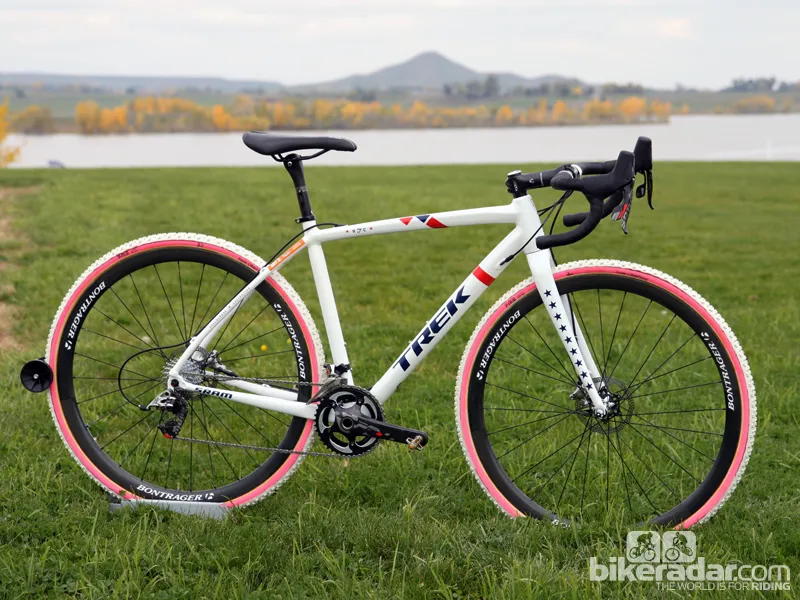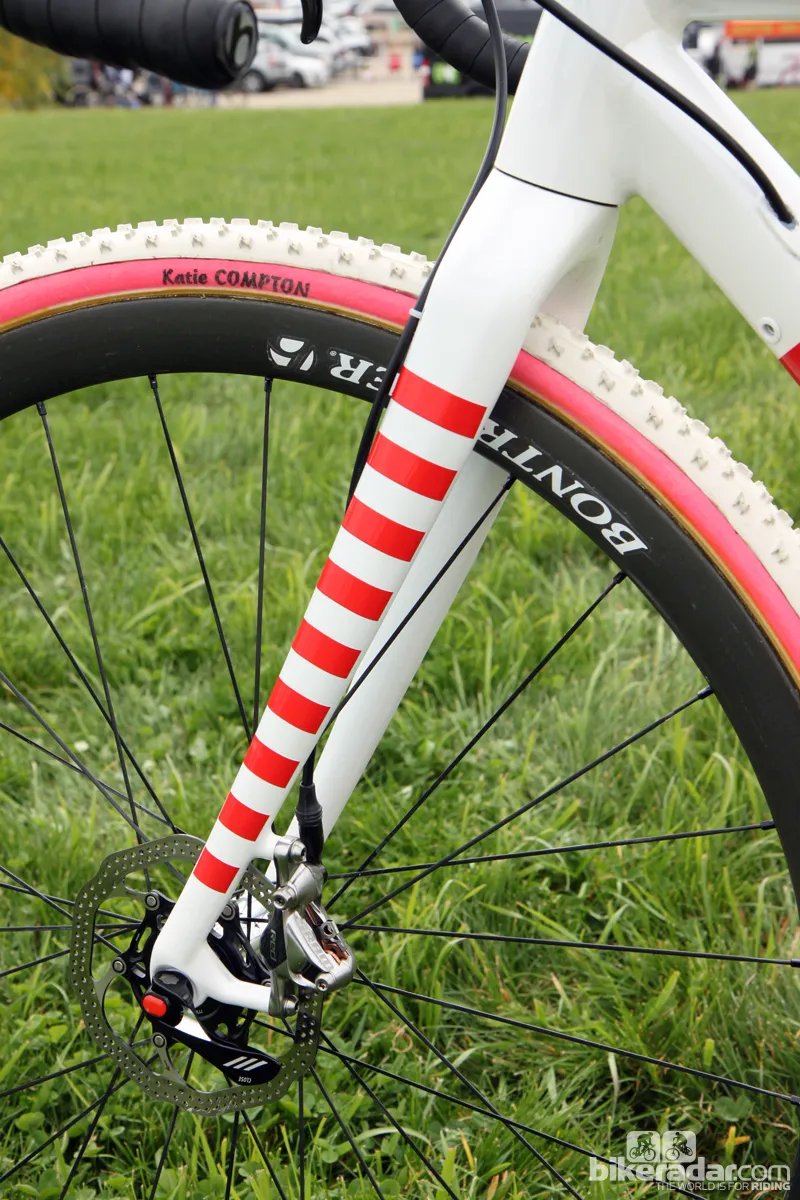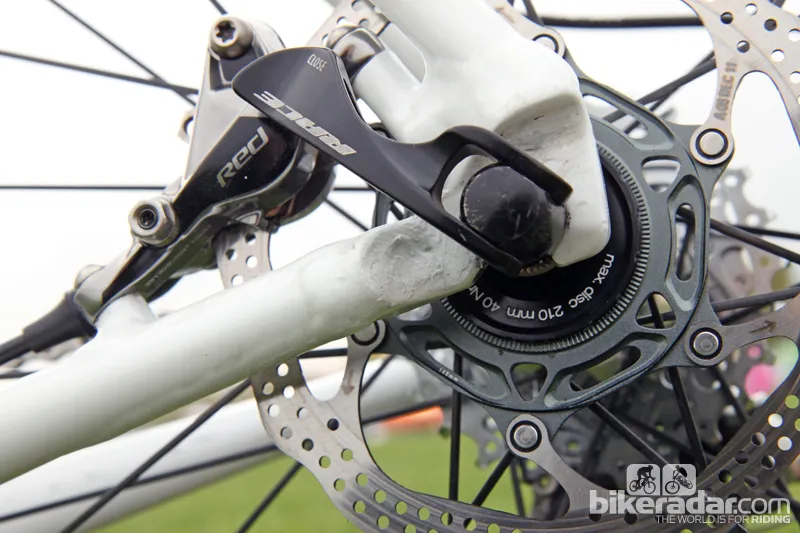Usually when a company signs a new star athlete to its team, that rider gets perhaps a special paint job and maybe some fancy parts. In the case of cyclocross superstar Katie Compton, though, Trek not only built a team around her – the Trek Cyclocross Collective – but also an entire new line of bikes based on her particular wants and needs.
Compton has long struggled with frame geometry on off-the-shelf 'cross bikes as she generally prefers a more forward position that she says helps her generate more power. As a shorter rider, however, she also often has issues with toe overlap but yet she also likes an aggressive handling chassis.
According to Compton's coach, mechanic and husband, Mark Legg-Compton, Trek's new Crockett handily addresses all of those issues by tweaking the front-end geometry.
"The biggest thing she was trying to address was front wheel overlap," he told BikeRadar. "Even though she rides 175mm cranks – and she doesn't have small feet – she only just nicks the tire with her toes so anyone riding a normal size for this bike won't have any issues."
Legg-Compton says that despite the Crockett having a longer front center and slacker head tube angle than Trek's current Cronus carbon fiber CX flagship, the new bike actually handles faster.
"When you turn the front wheel on a frame with steep geometry, you don't immediately put the tire on its edge – you're still on the midpoint of the tire. We've been noticing that the traction is even better and you can catch front wheel slides easier as well."
Chain stays are also shorter than on the Cronus and the Compton requested a steeper seat tube angle for what she says is a more powerful position for cyclocross.

As compared to Trek's carbon fiber Cronus CX, the Crockett features a shorter rear end, a slacker head tube and a steeper seat tube
Claimed frame weight for a 56cm aluminum Crockett frame is around 1,250g – impressive for an alloy chassis but still heavier than Trek's carbon fiber Cronus CX. Legg-Compton says the Crockett's better geometry trumps any comparatively minor weight savings, though – and not surprisingly, also hints that a new carbon variant is likely coming next year with the same angles.
"The nice thing we discovered at the Czech World Cup in Plzen is that the aluminum bike clears mud better. That turned out to be a big advantage there," he said. "Carbon will be in Katie's future but she's racing and winning World Cups on an aluminum bike so it still shows that it's a very viable material."
While some others have been quick to jump on the disc brake bandwagon, Compton is taking a decidedly more measured approach and perhaps rightfully so. After all, though it offers a lot of benefits in theory, it's still largely untested on the World Cup circuit, particularly in the often exceptionally nasty conditions of European races.
"Right now we're running disc bikes on the US side of things and in Europe we're going with cantilevers," he said. "We have a disc bike as an option there to test out because we just don't have any information on racing European-style races where the conditions are so much more challenging for the brakes. What little we saw of disc brakes before – obviously, they were mechanical – were issues with brake pad wear and so we want to take more of a measured approach to this and go with what we know works, and then introduce something and test it out when we're ready without going full hog."
"It's definitely been a steep learning curve. At Providence, you could definitely brake a little later, which, if you're doing an F1-style pass, works really well. The problem is that if everyone is on disc brakes, that negates the advantage. Aside from that, we haven't seen any real performance advantage with them yet. Maybe we'll start seeing that on the more challenging courses in Europe."

Katie Compton is taking a measured approach to disc brakes this year, using them mostly in the US but primarily sticking with cantilevers in Europe - for now
In particular, Legg-Compton expects to see a difference on courses with unusually steep sections – especially if it's muddy, snowy or icy – where the more consistent braking performance might play a bigger role.
"Trek has been super amazing in working with us on this. Anything Katie wants, Katie gets," he said – which in this case means four race bikes in Europe and four in the US, not to mention the enormous support package of wheels, components, shoes and clothing.
As always, there are a lot of tweaks to Compton's bike that set it apart from a standard off-the-shelf build. Legg-Compton has swapped out the standard pad springs in the Red 22 HRD disc calipers for softer ones that he says lends a better lever feel plus he's coated the shift paddles with glue and sand for a more positive grip in wet conditions.

WickWerks has made new 42/34T chainrings for Katie Compton that you will soon be able to buy yourself
Gearing has changed from before, too, from Compton's once-preferred 34/44T chainrings and 12-27T cassette to smaller 42/34T chainrings and an 11-26T cluster. WickWerks will soon offer the new combo as a stock offering.
"The gearing options have changed from SRAM with 11-speed – everything's got an 11-tooth cog," said Legg-Compton. "For a woman, and even the vast majority of amateurs, a 44-11 is just too big – you're never going to use it unless you're maybe on a group ride somewhere. I ran the gear calculations and found that with a 42-tooth chainring and an 11-26 cassette, you have a slightly lower gear in the crossover gear and a slightly bigger gear compared to the 44-12."
Compton's rolling stock is rather unique, too. Wheels are Bontrager's as-yet-announced carbon tubulars (we're guessing they'll either be called 'Race XXX Lite Disc Tubular' or 'Aeolus 3 D3 Disc Tubular') built with special disc-specific rims that shed a layer of carbon from the standard Aeolus 3 D3 rims since there are no brake tracks required. As the shape is actually based on the modified cross-section that the Leopard-Trek team uses in the spring classics, the rims also have a larger-radius tire bed that matches up better with high-volume 'cross tubulars.

Compton is currently using a new carbon disc tubular wheelset from Bontrager
Trek then mates those rims with straight-pull spokes to all-new hubs, built around DT Swiss internals with a 36-tooth star ratchet freehub mechanism for faster engagement than the company's standard road bits.
Wrapped around the new wheels are FMB Super Mud Pro tires, handbuilt in France by renowned tubular wizard François Marie. The aggressive tread is similar to the Dugast Rhino pattern that Compton used to run but it's apparently Marie's meticulous build quality and the Pro variant's specially coated sidewalls that make the difference.

The pink sidewalls aren't just for show. The latex coating improves durability and also allows for lower operating pressures
"The pink sidewall is kind of a latex material," he said. "It does two things: it greatly increases the life of the tire and it also cuts down on that compression fold-and-roll on steep drop-offs. We found we can run 2-3psi lower than on a standard cotton casing so it is a real performance advantage."
The sidewalls aren't the only place on the bike where you'll find some extra rubber, either. Since 'cross bikes see regular power washing, virtually every possible access point for water on Compton's bike is sealed with silicone glue, including the housing stops, the seat tube slots, and even the stem faceplate. Other Legg-Compton touches include cable ends finished with heat shrink tubing, brake hoses secured with beekeeper wire instead of zip ties, and some sort of special chain lube treatment that he preferred not to discuss.
Total weight is pictured is 8.14kg (17.95lb) – not the lightest around but somehow we get the feeling that it's not going to slow Compton down much.
Complete bike specifications
- Frame: Trek Crocket Disc, 52cm
- Fork: Trek IsoSpeed Cross carbon disc, 1 1/8-to-1 1/2in tapered
- Headset:Cane Creek integrated, 1 1/8-to-1 1/2in tapered
- Stem: Bontrager RXXXL, 120mm x -7°
- Handlebar: Bontrager RXL IsoZone, 42cm (c-c)
- Tape: Bontrager Gel Grip
- Front brake: SRAM Red 22 HRD, 140mm rotor
- Rear brake: SRAM Red 22 HRD, 140mm rotor
- Brake levers: SRAM Red 22 Hydro Shifter
- Front derailleur: SRAM Red 22
- Rear derailleur: SRAM Red 22
- Shift levers: SRAM Red 22 Hydro Shifter
- Cassette: SRAM PG-1170, 11-26T
- Chain: SRAM Red 22
- Crankset: SRAM Red 22 GXP, 175mm, with 42/34T WickWerks chainrings
- Bottom bracket: Truvativ PressFit GXP
- Pedals: Crankbrothers Eggbeater 4ti
- Wheelset: Bontrager Aeolus 3 D3 Tubular Disc (prototype)
- Front tire: FMB Super Mud Pro, 33mm, 20-21psi
- Rear tire: FMB Super Mud Pro, 33mm, 20-21psi
- Saddle: Bontrager Affinity R
- Seatpost: Bontrager RXXXL
Critical measurements
- Rider's height: 1.68m (5ft 6in)
- Rider's weight: 61kg (135lb)
- Saddle height from BB, c-t: 691mm
- Saddle setback: 15mm
- Seat tube length (c-t): 495mm
- Seat tube length (c-c): 445mm
- Tip of saddle to center of bar: 501mm
- Saddle-to-bar drop: 38mm
- Head tube length: 123mm
- Top tube length (effective): 531mm
- Total bicycle weight: 8.14kg (17.95lb)


















